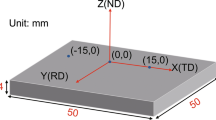Abstract
The plain strain of AZ31 magnesium alloy sheet in magnetic pulse forming was investigated by numerical simulation and experimental method. Combination of uniform pressure coil and Holmberg’s specimen was employed to evaluate the plain strain of AZ31 sheet. The numerical simulation for magnetic pulse plain strain of AZ31 sheet is performed by means of ANSYS FEA software. The magnetic flux density of uniform pressure coil was distributed uniformly, especially at the center of gauged area of AZ31 sheet directly in relation to the deformation behavior of AZ31 sheet. The velocity of typical point increases as increasing energy, and the more position closes to the center of sheet the higher velocity achieves. The forming height is increased with increasing discharge voltage. Compared with C=768 µF and C=1536 µF, the capacitance of 1152 µF is more effective for forming, which is confirmed by experiments. The peak velocity at the center of sheet is about 105 m/s. The major strains of magnetic pulse plane strain lie approximately in the strain ranges of 5.83-6.45%. However, the 3.22-3.82% (major strain) are the limit strains in quasi-static condition. The experimental results indicate that the major strain of AZ31 sheet improves about 75% compared with the quasi-static case.
Similar content being viewed by others
Abbreviations
- V:
-
Forming velocity
- E:
-
Discharge energy of system
- C:
-
System capacitance
- U:
-
Input voltage
References
Kapitza, P. L., “A Method of Producing Strong Magnetic Fields,” Proceedings of the Royal Society of London. Series A, Containing Papers of a Mathematical and Physical Character, Vol. 105, pp. 691–710, 1924.
Harvey, G. W. and Brower, D. F., “Metal Forming Device and Method,” US Patent, No. 2976907A, 1961.
Psyk, V., Risch, D., Kinsey, B. L., Tekkaya, A. E., and Kleiner, M., “Electromagnetic Forming–A Review,” Journal of Materials Processing Technology, Vol. 211, No. 5, pp. 787–829, 2011.
Daehn, G. S., Altynova, M., Balanethiram, V., Fenton, G. K., Padmanabhan, M., et al., “High-Velocity Metal Forming–An Old Technology Addresses New Problems,” JOM, Vol. 47, No. 7, pp. 42–45, 1995.
Balanethiram, V. S. and Daehn, G. S., “Hyperplasticity: Increased Forming Limits at High Workpiece Velocity,” Scripta Metallurgica et Materialia, Vol. 30, No. 4, pp. 515–520, 1994.
Golovashchenko, S. F., Gillard, A. J., and Mamutov, A. V., “Formability of Dual Phase Steels in Electrohydraulic Forming,” Journal of Materials Processing Technology, Vol. 213, No. 7, pp. 1191–1212, 2013.
Imbert, J. M., Winkler, S. L., Worswick, M. J., Oliveira, D. A., and Golovashchenko, S. F., “The Effect of Tool-Sheet Interaction on Damage Evolution in Electromagnetic Forming of Aluminum Alloy Sheet,” Journal of Engineering Materials and Technology, Vol. 127, No. 1, pp. 145–153, 2005.
Noh, H.-G., Song, W.-J., Kang, B.-S., and Kim, J., “3-D Numerical Analysis and Design of Electro-Magnetic Forming Process with Middle Block Die,” Int. J. Precis. Eng. Manuf., Vol. 15, No. 5, pp. 855–865, 2014.
Van Benthysen, R., Thibaudeau, E., and Kinsey, B. L., “Effect of Specimen Planar Area on Electromagnetic Flanging,” Journal of Manufacturing Processes, Vol. 15, No. 2, pp. 194–200, 2013.
Oliveira, D., Worswick, M. J., Finn, M., and Newman, D., “Electromagnetic Forming of Aluminum Alloy Sheet: Free-Form and Cavity Fill Experiments and Model,” Journal of Materials Processing Technology, Vol. 170, No. 1, pp. 350–362, 2005.
Golowin, S., Kamal, M., Shang, J., Portier, J., Din, A., et al., “Application of a Uniform Pressure Actuator for Electromagnetic Processing of Sheet Metal,” Journal of Materials Engineering and Performance, Vol. 16, No. 4, pp. 455–460, 2007.
Xu, J. R., Yu, H. P., and Li, C. F., “An Experiment on Magnetic Pulse Uniaxial Tension of AZ31 Magnesium Alloy Sheet at Room Temperature,” Journal of Materials Engineering and Performance, Vol. 22, No. 4, pp. 1179–1185, 2013.
Xu, J. R., Yu, H. P., Cui, J. J., and Li, C. F., “Formability of AZ31 Magnesium Alloy Sheets during Magnetic Pulse Bulging,” Materials Science and Engineering: A, Vol. 569, pp. 150–158, 2013.
Peixinho, N. and Doellinger, C., “Characterization of Dynamic Material Properties of Light Alloys for Crashworthiness Applications,” Materials Research, Vol. 13, No. 4, pp. 471–474, 2010.
Azrin, M. and Backofen, W. A., “The Deformation and Failure of a Biaxially Stretched Sheet,” Metallurgical Transactions, Vol. 1, No. 10, pp. 2857–2865, 1970.
Bariani, P. F., Bruschi, S., Ghiotti, A., and Turetta, A., “Testing Formability in the Hot Stamping of Hss,” CIRP Annals- Manufacturing Technology, Vol. 57, No. 1, pp. 265–268, 2008.
Wagoner, R. H. and Wang, N.-M., “An Experimental and Analytical Investigation of In-Plane Deformation of 2036-T4 Aluminum Sheet,” International Journal of Mechanical Sciences, Vol. 21, No. 5, pp. 255–264, 1979.
Holmberg, S., Enquist, B., and Thilderkvist, P., “Evaluation of Sheet Metal Formability by Tensile Tests,” Journal of Materials Processing Technology, Vol. 145, No. 1, pp. 72–83, 2004.
Cui, X.-H., Mo, J.-H., Xiao, S.-J., and Du, E.-H., “Magnetic Force Distribution and Deformation Law of Sheet using Uniform Pressure Electromagnetic Actuator,” Transactions of Nonferrous Metals Society of China, Vol. 21, No. 11, pp. 2484–2489, 2011.
Xu, J. R., Cui, J. J., Lin, Q., Li, Y., and Li, C. F., “Magnetic Pulse Forming of AZ31 Magnesium Alloy Shell by Uniform Pressure Coil at Room Temperature,” The International Journal of Advanced Manufacturing Technology, Vol., No. pp. 1–16, 2014.
Al-Hassani, S., Duncan, J., and Johnson, W., “On the Parameters of the Magnetic Forming Process,” Journal of Mechanical Engineering Science, Vol. 16, No. 1, pp. 1–9, 1974.
Werway, R. A. and Jewett, J. W., “Physics for Scientists and Engineers,” Cengage Learning, 7th Ed., pp. 1–19, 2007.
Author information
Authors and Affiliations
Corresponding authors
Rights and permissions
About this article
Cite this article
Xu, JR., Cui, JJ., Sun, GY. et al. Experimental and numerical research on process formability in magnetic pulse forming of AZ31 magnesium alloy sheets. Int. J. Precis. Eng. Manuf. 16, 1779–1788 (2015). https://doi.org/10.1007/s12541-015-0233-8
Received:
Revised:
Accepted:
Published:
Issue Date:
DOI: https://doi.org/10.1007/s12541-015-0233-8



